Stuck in Halftime (by Bob Buford)
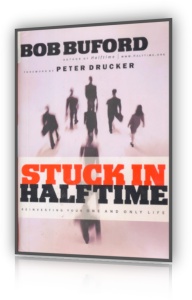
Amazon link: Stuck in Halftime
This page is linked from The Second Half of Your Life
In any game, the second half is the most crucial one.
With the charisma of a motivational coach, bestselling author Bob Buford exhorts successful 40-plus readers who are yearning for meaning to avoid getting "stuck in halftime." The second half of life is the time to self-analyze, make adjustments, stick with a plan, keep moving forward, and never give in to the temptation to relax or quit.
Buford, a second-halfer himself and the founder of Leadership Network, a support ministry for pastors and church leaders, blends both success and failure stories, anecdotes, Web resources, and wisdom from his previous books, ("Halftime" and "Game Plan") to spur readers to action.
In the three sections of this compact volume, he examines why people get stuck in the second half (halftime), gives practical advice for getting unstuck, and offers help for living a second half with significance.
An ideal, purposeful second half is one where work, meaning, and happiness merge, and readers can be fully engaged in activities that match their skills, capacity, and mission, he writes.
If these factors are in place, Buford believes second-halfers will find satisfaction in work that adds meaning and purpose to life.
"The second half is where the joy is," he writes. "
— Cindy Crosby
Contents
- The World Is Full Of Options (Foreword by Peter Drucker)
- Preface: Do You Feel It?
- Section One: Stuck In Halftime
- Beyond Good Intentions
- Stuck Is Good
- What Did You Expect?
- Tried It, Didn't Work
- Detoxing From The Addiction To Success
- The False Paths Of Halftime
- The Homestead
- Leisure World
- The Wages Of Boredom
- Keeping Your Dream Ahead Of You
- The Myths Of Halftime
- The Peter Pan Myth
- The Leisure World Myth
- The Gatsby Myth
- The Former Great Person Myth
- The Harper Lee Myth
- The Money Myth
- The Solomon Myth
- The Low Commitment Myth
- The Aging Myth
- Section Two: Into The Second Half
- The Twenty-First Century: A World Of Opportunity
- The Twelve Positive Commandments
- 1. Longevity
- 2. Affluence
- 3. Options
- Sabbatical
- Work at Home
- Early Retirement
- New Rules For The Second Half (see the wisdom of Peter Drucker)
- So What Are The New Rules?
- Begin with yourself
- Take care of your family first
- Find an organizational vehicle that fits your dream
- Build on the islands of health and strength
- Just do it!
- Work only with the receptive
- Pay your dues
- All work is done in teams
- Find a mentor
- The Halftime Transition Toolbox
- Money
- Low-Cost Probes
- Parallel Career
- More with Less
- Time
- Focus days
- Buffer days
- Free days
- What's In The Box?
- Self-Assessment
- A Brand New BHAG (Big Hairy Audacious Goal)
- The Opportunity Scan (See Opportunities by Edward de Bono)
- Strategic Planning
- Build A Halftime Team
- Find Your Role
- The Hero
- The Hero's Partner
- The Hero's Patron
- The Hero's Expert
- The Hero's Team
- Section Three: The Inspiration Of Significance
- The Elusive Nature Of Significance
- Leading Level 5 Lives
- The Need For A Heroic Second Half
- What Do You Want To Be Remembered For?
- The End Of The Beginning
- About Discouragement
- Acknowledgements
- "Toolkit of Resources" for those who want to drill deeper
- Programs
- The Master's Program—A three-year life coaching program
- Halftime ZondervanGroupware™—Video with participant's guide
- The Strategic Coach
- Wise Counsel
- Books
- Halftime, by Bob Buford
- Game Plan, by Bob Buford
- Balancing Life's Demands, by J. Grant Howard
- Believers in Business, by Laura L. Nash
- Business as a Calling: Work and the Examined Life, by Michael Novak
- Celebration of Discipline, by Richard J. Foster
- Connecting, by Larry Crabb
- Discontinuity and Hope: Radical Change and the Path to the Future, by Lyle E. Schaller
- Experiencing God, by Henry Blackaby
- Finding a Job You Can Love, by Ralph Mattson and Arthur Miller
- High Performance Nonprofit Organizations
- Leader to Leader, by Frances Hesselbein and Paul M. Cohen
- Leadership by the Book, by Ken Blanchard, Bill Hybels, and Phil Hodges
- Leadership Is an Art, by Max DePree
- The Life@ Work Journal
- Living the life You Were Meant to Live, by Tom Paterson
- Managing the Non-Profit Organization, by Peter F. Drucker
- Management Challenges for the 21st Century, by Peter F. Drucker
- Margin, by Richard A. Swenson
- The Millionaire Next Door, by Thomas J. Stanley and William D. Danko
- Mornings with Henri J. M. Nouwen
- The Paradox of Success: When inning at Work Means Losing at Life, by John R. O'Neil and Jeremy Tarcher
- The Path, by Laurie Beth Jones
- The Spirit of the Disciplines: Understanding How God Changes Lives, by Dallas Willard
- Teaching the Word of Truth, by Donald Grey Barnhouse
- Transitions: Making Sense of Life's Changes, by William Bridges
- What Color Is Your Parachute? by Dick Bolles
- The Unfinished Presidency. Jimmy Carter's Journey Beyond the White House, by Douglas Brinkley
- We Are the Beloved, by Ken Bianchard
- Conferences/Seminars
- Developing Your Game Plan Workshop
- Center for FaithWalk Leadership Conference
- The Gathering Conference
- Time Out Model
- Second Half Ministries Forums
- The Trinity Forum
- Audiotapes
- Bob Buford's Favorite 12 Talks from The Foundation Conferences 1989-97
- Halftime: Men Facing Midlife
- Living a Legacy, Beyond Success to Significance
- Making Sense Out of Money: Leveraging Your Money for Eternity
- Mars Hill Tapes
- Pastor to Pastor—Vol. 45-Spiritual Leadership in the 21 Century
- Strategies for Going from Success to Significance
- Thinking Clearly About Spiritual Growth—Parable of The Sower, The Four Soils, Luke 8:4-15
- William Wilberforce, A Man Who Changed His Times
- Life Coaching
- OnCourse™ International
- CoachWorks® International
- Family Wealth Counselors
- The Hendricks Group
- PathFinders
- Financial
- A Life Well Spent by Russ Crosson
- Ron Blue & Co.—Professional, Bible-based financial counsel
- Trinity Community Foundation
- Oxford Financial Advisors
- Second Half Service/Ministry Models
- The Barnabas Group
- SHINE Model
- TCC Model
Half Time series

Amazon
Amazon links (work-around for browser ad blocking)
The World Is Full Of Options by Peter Drucker
The following is an “enhanced” version of the original text. The enhancements are probably pretty obvious — bobembry
In a few hundred years, when the history of our time is written from a long-term perspective, I think it very probable that the most important event those historians will remember is not technology, not the Internet, not e-commerce—but the unprecedented change in the human condition.

For the first time—and I mean that literally—substantial and rapidly growing numbers of people have choices.
For the first time, people have had to manage themselves.
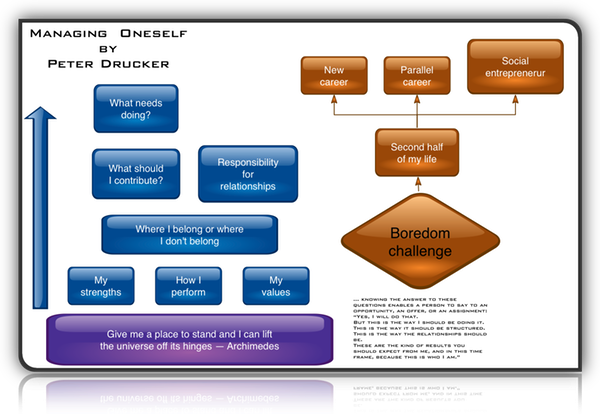
Larger

Larger thinking canvas (see below)
Dense reading and Dense listening ::: Thinking broad and Thinking detailed
And we are totally unprepared for it.
Up until around 1900, even in the most highly developed countries, the overwhelming majority of people simply followed in their father's footsteps—if they were lucky.

If your father was a peasant farmer, you were a peasant farmer.
If he was a craftsman, you were a craftsman.
There was no such thing as upward mobility.
Now, suddenly, a large number of people choose what they want to be.
And what's more, they have more than one career.
The average working life span is now close to sixty years.
In 1900, it was twenty.
In a short time, we will no longer believe that retirement means the end of working life.
Retirement may even come much earlier than ever, but working life will continue if only out of economic necessity.
For many, however, working well beyond retirement will be a choice based on preference.
They will either tire of luxury or desire to use their knowledge and experience to contribute to society.
Knowledge: Its Economics and Its Productivity
(See what do you want to be remembered for? (beware of good intentions) and Post-Capitalist Society)
Even during their now traditional thirty- to forty-year working lives, most people have options that never existed for their parents, and they exercise those options several times.
When I talk to the people in my executive management program (successful people who are forty-five years old on average, sixty percent of whom are in the business sector, forty percent in nonbusiness), everyone says, “I do not expect to end my career where I am working now.” (implications for top management?)
To take advantage of this unprecedented age of options
we need to learn
(not school learning — but learning that becomes a part of you)
who we are
We don't know
When I ask my students, “Do you know what you’re good at?” almost no one knows. (calendarize this?)
Notice he didn’t say knowledge specialty. See taking on assignments

Elements of a work approach
I (bobembry) suggest you create a thinking canvas for each of his questions and regularly update them throughout your life.
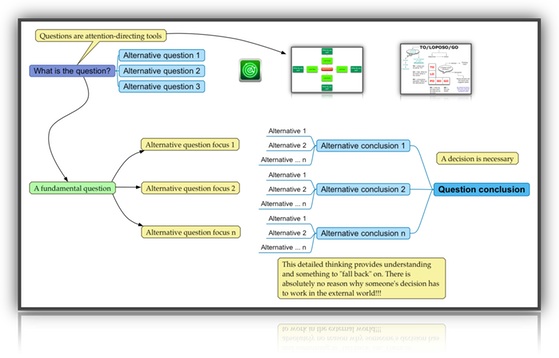
Larger
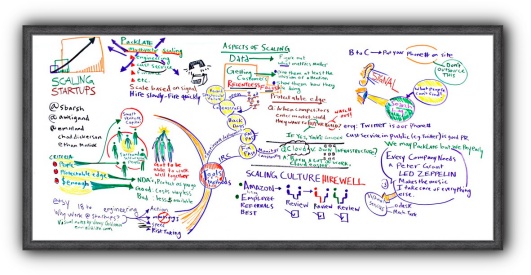
Larger
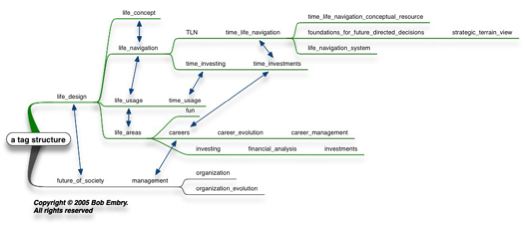
Larger
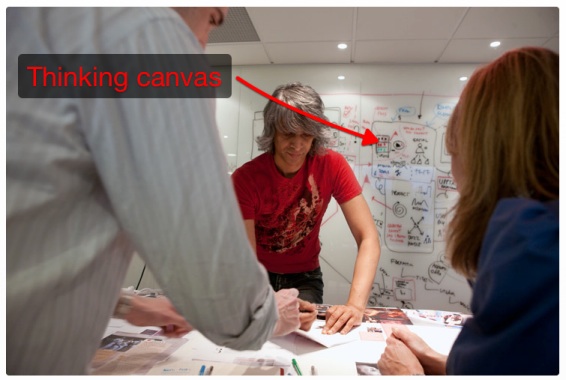
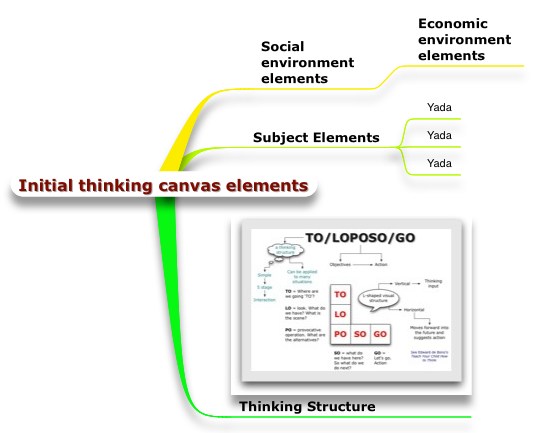
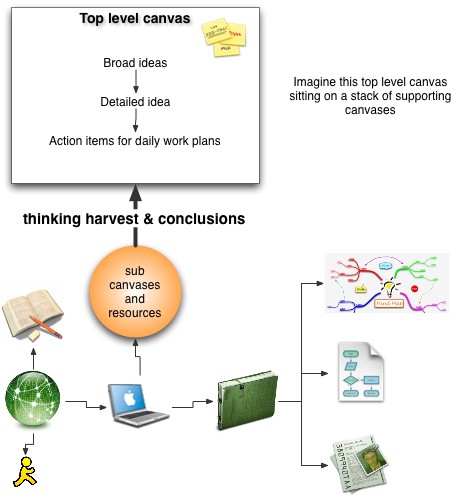
Wall chart: radar blips to consider

“Do you know what you need to learn to get the full benefit of your strengths?” (calendarize this?)
Not one of them has even asked that question.
Again he's not talking about knowledge specialty, but that may be something you have to learn so you can employ your strengths.
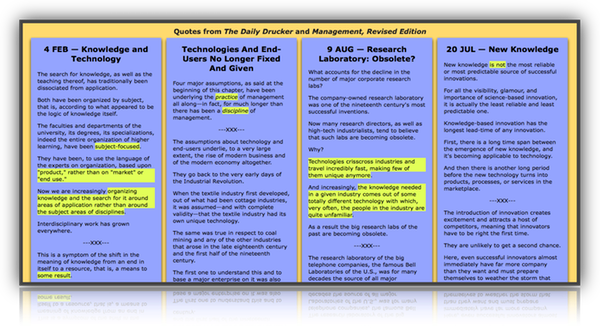
Larger
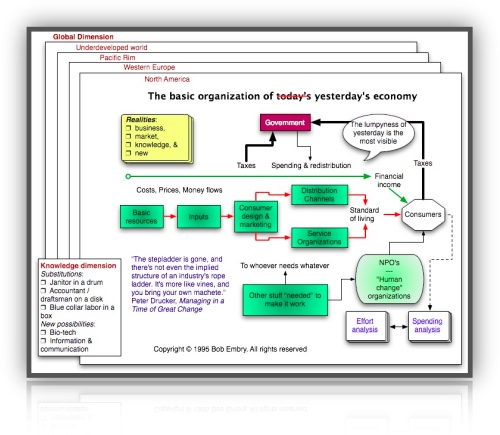
Economic content & structure, money flows, efforts, and consumer lives
Few people know where they belong, what kind of temperament they have, or what kind of person they are.
“Do I work well with people or am I a loner?” (calendarize this?)
“What are my values?” (calendarize this?)
“What am I committed to?” (calendarize this?)
”Where do I belong?” (calendarize this?)
“What is my contribution?” (calendarize this?)
Many people intuitively know the answers to these questions, but because they do not work through them systematically, they often sell themselves short.
So we find ourselves in an unprecedented place: The most educated people in history, with a world full of options for meaningful work, and yet unsure of just where we belong. (calendarize “What is meaningful work?”)
Those who want to live a fulfilling life—who want to feel as if there is some purpose in their being on this earth—will have to learn to manage themselves.
They will have to accept the fact that it is their own responsibility to find meaningful work (he did't say job) that builds on their strengths and values. (calendarize this?)
Foundations for future directed decisions
 Post-capitalist society ::: the transformation Post-capitalist society ::: the transformation
 Managing in the Next Society Managing in the Next Society
 Peter's Principles Peter's Principles
 From Analysis to Perception — The New Worldview From Analysis to Perception — The New Worldview
 See The Five Most Important Questions You Will Ever Ask About Your Nonprofit Organization and Managing the Nonprofit Organization for clues to meaningful work See The Five Most Important Questions You Will Ever Ask About Your Nonprofit Organization and Managing the Nonprofit Organization for clues to meaningful work
 Josh Abrams and self-development summary Josh Abrams and self-development summary
 How to guarantee non-performance and How to guarantee non-performance and
 What results should you expect? — a user’s guide to MBO What results should you expect? — a user’s guide to MBO
 Carefully choosing your nonprofit affiliations Carefully choosing your nonprofit affiliations
Look here
 What do you want to be remembered for? What do you want to be remembered for?
As this happens, I believe more and more people will look to the social sector—volunteer organizations like the church, education, community services, and so on—for either a new career or one that parallels a current position.
This is the one place where the knowledgeable worker in an organization can actually discover who he or she is and can learn to manage him or herself.

Larger

Living in More Than One World:
How Peter Drucker’s Wisdom Can Inspire Your Life by Bruce Rosenstein
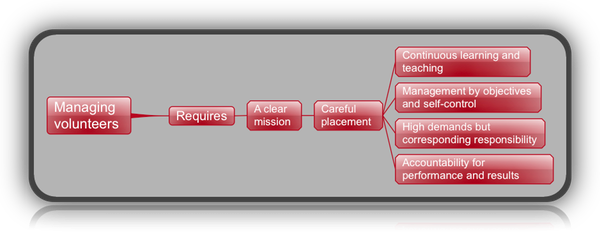
Larger
Mission
Bob Buford has done a great service in his first book, Halftime, by showing people how to explore this wonderful world of options.
In this book he offers encouragement and motivation for those who have begun to seek their “Second Half career” but are not quite there … yet.
Find Your Role
I believe one of the unintentional effects of my first book, Halftime, is that it left the impression that there is a single role for you to play in the Second Half, and that role is one of leader or entrepreneur.
Therefore, some may be stuck in Halftime because they may never be able to fit that role.
Actually, I see at least five roles that are legitimate avenues to significance in the Second Half.
Each goes beyond the roles of small donor and occasional volunteer.
None is more important than the other, and where you fit in has a lot to do with what you have discovered in your self-assessment.
The Hero
This is the top gun; the one who assumes leadership.
A true entrepreneur who enjoys risk and has the qualities of a leader—the ability to develop a BHAG and recruit talented people and money to convert the dream to reality.
The Hero's Partner
Fans of the magazine Christianity Today know that Harold Myra is the publisher and is seen as the visionary leader who built the magazine into a family of eight successful publications.
What some do not always realize is that Paul Robbins has been along side providing much of the business support for the enterprise.
Harold is the hero; Paul the hero's partner.
You may fit best as a partner, working alongside someone more comfortable being out front.
I have been Frances Hesselbein's partner in the first ten years of the Peter F. Drucker Foundation for Nonprofit Management.
I feel that I have made an important and valuable contribution in that role.
The Hero's Patron
People with a true gift for making money ought to consider the role of patron as Second Half career.
But here I am not talking about a disinterested donor who merely writes checks, but an active partner in the enterprise so that he or she assumes "ownership."
The great story of patronage is the Medici family who sponsored the Renaissance in art in fifteenth-century Florence.
The patrons were as central to this golden age as were the artists.
No patrons.
No great art.
The Hero's Expert
Here again, it may be that the role you will play best is in providing guidance to someone who has formed a Second Half enterprise.
Ken Jennings, an exAir Force fighter pilot and instructor, has left a seven-figure annual income partners slot at Anderson Consulting to begin VentureWorks, a firm that seeks to bring Anderson level consulting to bear on Christian enterprises.
Tom Tierney, the worldwide chairman of Bain & Company, has just (Spring 2000) announced the formation of the Bridge Group to bring the sort of world-class expertise to bear on social sector organizations that giant corporations have received for years.
Why shouldn't nonprofit work get the first team?
Man doesn't live by bread alone.
The Hero's Team
Quite a few people who have more money than meaning in their lives are switching to full-time work in nonprofit organizations.
They join the staff on a paid basis to play a forty-hour-a-week role on the leadership team of an organization that connects with their passions.
The pay is less but they find the focus on doing something that makes a difference in peoples' lives well worth the economic sacrifice.
John Purcell, who honed his corporate skills at Westinghouse is now executive pastor at Perimeter Church in Atlanta, where over nine thousand people attend each week in fifteen locations.
Gary Schwammlein, who headed international operations for the NutraSweet division of Monsanto, is now heading international development for the Willow Creek Association based in Chicago.
Putting on conferences and developing relationships all over the world is a natural fit for Gary.
These are the five major roles that are the serious commitments beyond volunteering and donations. Which one fits you?
The tools of Calendarization, Conceptual Resource Digestion Process, and Concepts to Daily Action will surely be valuable in navigating your journey in the second half of your life.
|


![]()
![]()